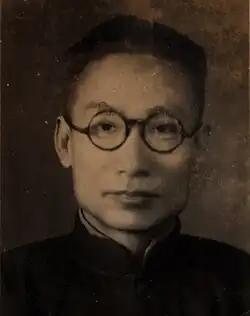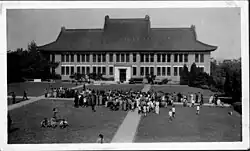Qi Zhaochang

Qi Zhaochang (Chinese: 齐兆昌; 1880–1956) was a Chinese architect and civil engineer. He earned a master’s degree in civil engineering from Ohio State University, worked on campus and church buildings in Nanjing including projects at Jinling University and St. Paul’s Church, and taught agricultural engineering at Jinling University.
Early life and career
Qi was born in Hangzhou, Zhejiang in 1880.[1] He received financial assistance from the Christian Church and graduated from Zhejiang University while working as a daily bell-ringer. He later obtained a master's degree in civil engineering from Ohio State University in the United States.
Career
After returning to China, Qi worked as an engineer at the Jiangxi Guling Engineering Bureau. After completing the design of St. Paul's Church, Nanjing,[2] he left his position at the Presbyterian Architectural Office in northern Shanghai and joined the Engineering Office of Jinling University, where he was also a professor of agricultural engineering.[3]
During the 1920s, Qi oversaw the engineering and construction of the North Building, as well as the design and construction of the West Building at Jinling University. He was involved in construction of the Science and Technology Museum, the university gymnasium, several student dormitories (Buildings A-D), and faculty housing. His other architectural projects included Twinem Memorial Chapel, Ginling College, and Nanjing Zhonghua High School.[4][5]
Following the September 18th Incident and Japan's annexation of Northeast China, anti-Japanese sentiment grew in the region. In September 1934, a steel-framed flagpole was erected at the Japanese Embassy in China, adjacent to Jinling University, and reaching the height of the university's North Building. The daily visibility of the Japanese flag was a source of discontent among the university's faculty and students. In early October, a group of 30 students proposed constructing a taller flagpole to express national pride. With the university's support, a new steel flagpole, designed by Qi Zhaochang, was constructed.[6] Completed in August 1935, the flagpole measured over forty meters in height, with the Chinese national flag extending more than three meters above the North Building and rising higher than the adjacent Japanese flag. The initiative was widely supported by the Jinling University community.[7]

Following the onset of the Battle of Shanghai, Jinling University was compelled to relocate westward. To safeguard the university's assets, Qi remained in Nanjing alongside approximately 30 other Chinese and Western faculty members.[8] In December 1937, he became a member of the Emergency Committee of Jinling University,[9] concurrently serving as the head of the third district of the Nanjing Safety Zone and as a member of the Housing Committee.[10][11]
During the Nanjing Massacre, a refugee shelter was established on the university campus, and Qi was appointed its director. The shelter, located in one of the dormitories, accommodated over 30,000 refugees.[12] Despite its designation as part of the Safety Zone, the shelter was repeatedly entered by armed Japanese soldiers, who reportedly detained Chinese soldiers and policemen. They also abducted women, with multiple reports of sexual violence.[13] Residential buildings and stores on campus were looted and, in some cases, set on fire.
As director of the Refugee Shelter, Qi faced personal danger. On one occasion, when Japanese troops reportedly intended to execute him, Charles Riggs, a professor in the Department of Agronomy at Jinling University, intervened and prevented the killing.[14][15]
In 1942, after the Japanese army occupied the Jinling University campus, Qi Zhaochang and other staff relocated to Ganheyan adjacent to Huiwen College, which was renamed "Tonglun Middle School" (now Jinling High School). Qi served as the general administrator, helping to maintain educational activities for out-of-school youth and supporting the faculty in sustaining operations.[16]
Following Japan's surrender in 1945, Qi continued his work at the university. In 1952, during the national reorganization of higher education institutions, Jinling University was merged with other colleges to form the new Nanjing University, where Qi was appointed director of the Public Works Department. He died of cancer at Gulou Hospital in 1956.[17]
Family
His youngest son, Qi Kang, is an architect who designed the Memorial Hall of the Victims in Nanjing Massacre by Japanese Invaders.[18]
References
- ^ 张连红; 王卫星; 刘燕军; 杨夏鸣 (2022-06-01). 南京大屠杀国际安全区研究 (in Chinese). 江苏人民出版社有限公司. p. 23. ISBN 978-7-214-26744-3. Retrieved 2025-04-23.
- ^ 南京民国建筑艺术 (in Chinese). 江苏科学技术出版社. 2000. p. 10. ISBN 978-7-5345-3087-6. Retrieved 2025-04-23.
- ^ 南京民国建筑 (in Chinese). 南京大学出版社. 2001. p. -190. ISBN 978-7-305-03670-5. Retrieved 2025-04-23.
- ^ 苏克勤; 苗立军 (2008). 散落在大街小巷的流年碎影: 南京名人旧居 (in Chinese). 河南人民出版社. ISBN 978-7-215-06417-1. Retrieved 2025-04-23.
- ^ "历史补遗:教会建筑师齐兆昌和他的南京1937_金陵". 搜狐 (in Chinese). 2020-10-26. Retrieved 2025-04-23.
- ^ Sheng, Zhang (2021-11-08). The Rape of Nanking: A Historical Study. Walter de Gruyter GmbH & Co KG. ISBN 978-3-11-065289-5. Retrieved 2025-04-23.
- ^ "齐兆昌设计了南大多个标志性建筑 抗战爆发后他留守南京保护校产-南京大学". 南京大学 (in Chinese). 2014-11-25. Retrieved 2025-04-23.
- ^ 刘家峰; 刘天路 (2003). 抗日战争时期的基督敎大学 (in Chinese). 福建教育出版社. p. 89. ISBN 978-7-5334-3616-2. Retrieved 2025-04-23.
- ^ 金陵大学史料集 (in Chinese). 南京大学出版社. 1989. p. 49. ISBN 978-7-305-00274-8. Retrieved 2025-04-23.
- ^ 经盛鸿 (2005). 南京沦陷八年史, 1937年12月13日至1945年8月15日 (in Chinese). 社会科学文献出版社. ISBN 978-7-80190-582-6. Retrieved 2025-04-23.
- ^ Xia, Yun (2017-12-11). Down with Traitors: Justice and Nationalism in Wartime China. University of Washington Press. p. 118. ISBN 978-0-295-74287-8. Retrieved 2025-04-23.
- ^ Xia, Yun (2017-12-11). Down with Traitors: Justice and Nationalism in Wartime China. University of Washington Press. ISBN 978-0-295-74287-8. Retrieved 2025-04-23.
- ^ 南京大屠杀史料集: 拉贝日记 (in Chinese). 江苏人民出版社. 2005. p. 299. ISBN 978-7-214-01963-9. Retrieved 2025-04-23.
- ^ "南京安全区中方工作人员的构成、角色及作用". 侵华日军南京大屠杀遇难同胞纪念馆 (in Chinese). 2016-07-05. Retrieved 2025-04-23.
- ^ 尹集钧 (1997). 1937, 南京大救援: 西方人士和国际安全区 (in Chinese). 文匯出版社. p. 62. ISBN 978-7-80531-492-1. Retrieved 2025-04-23.
- ^ "建筑师齐兆昌用生命守护难民收容所". 侵华日军南京大屠杀遇难同胞纪念馆 (in Chinese). Retrieved 2025-04-23.
- ^ "张铭:建筑学家齐康的父亲齐兆昌,在日本刺刀下救护难民". 江苏省情网--江苏省地方志工作办公室主办 (in Chinese). 2024-12-12. Retrieved 2025-04-23.
- ^ "SEU人物". 齐康:用建筑谱写永不消失的“城市记忆”_澎湃号·政务_澎湃新闻-The Paper (in Chinese). 2019-12-19. Retrieved 2025-04-23.